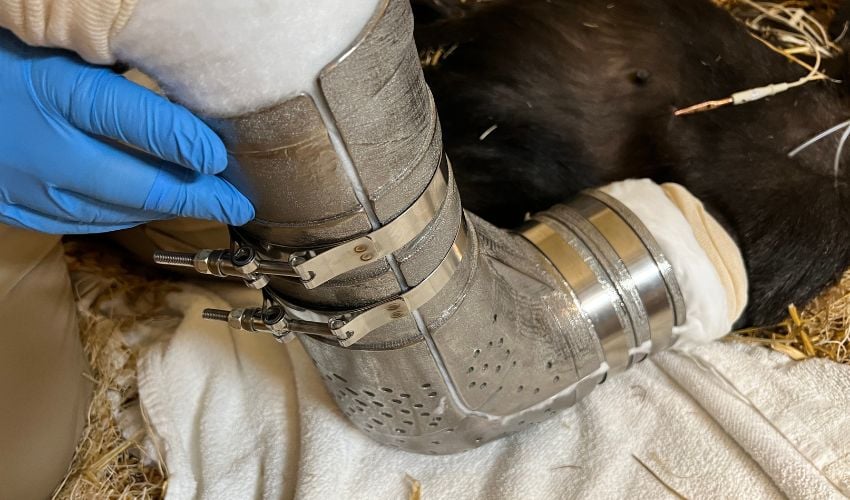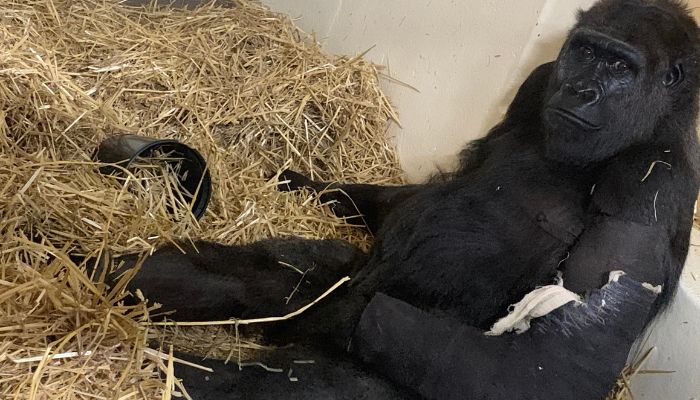Gorilla Receives World’s First, 3D Printed Titanium Cast to Heal Broken Arm

We all know about additive manufacturing’s benefits when it comes to creating prosthetics and orthotics for human beings, but what about one of humanity’s closest living relatives (after chimpanzees and bonobos)? Well, for at least one primate, it seems that AM is the key to better veterinary care. Cincinnati Zoo has announced that one of its gorillas, eleven-year-old Gladys, will be receiving a world-first, a titanium, 3D-printed cast. The hope is that this stronger and customized version will be harder to break as well as more comfortable for the gorilla during the at least 6-week recovery period.
According to a press release from Cincinnati Zoo, Gladys had to undergo surgery to repair a broken humerus after a scuffle with two younger females in her troop. The complete, oblique facture is not one commonly seen at the zoo, which is why the vet staff enlisted the expertise of top surgeons and anesthesiologists from local hospitals. Furthermore, after seeing that Gladys was at risk of destroying her cast, they reached out to GE Additive to create the titanium, 3D printed cast.

Gladys’ temporary cast lacked durability, a detriment to the healing process
Creating a Titanium, 3D Printed Cast for a Gorilla
Thanks to the flexibility and speed of additive manufacturing, Gladys did not need to wait long for her new cast. Shannon Morman, advanced lead engineer at GE Additive (now Colibrium Additive), who was on-site to help with any necessary adjustments, explained “One benefit of 3D printing is fast turnaround times. Following a call on Friday afternoon, our team met up over the weekend to create initial design ideas. The following Monday we scanned the original cast to create a 3D model and were ready to start printing the same day. The titanium cast took around 65 hours to print, and we were able to deliver it to the Zoo team in under a week.”
The final result is an 8-lb cast, which the Cincinnati Zoo hopes will be more “gorilla-proof.” In any case, given the use of titanium, it should be. The material is one of the strongest materials of Earth which, along with its biocompatibility, is one of the reasons it was also used for the screws and plates that will be part of her arm for the rest of her life. Furthermore, the weight should not be a problem thanks to the immense strength in a gorilla’s arms.
In any case, the cast for now seems to be a bigger success than the temporary one. Victoria McGee, Cincinnati Zoo’s zoological manager of primates, elaborates, “That doesn’t mean that she likes it! But she is tolerating it better than she did the first one. She’s been locomoting comfortably, adapting her movements to the cast carefully and safely! Before the titanium cast, we were very limited on the spaces Gladys could safely be in. With this addition, Gladys can ‘graduate’ to additional behind-the-scenes spaces that will allow her to have more choice and exploration throughout the day.” You can learn more about Gladys and her 3D printed, titanium cast in the video below or in a press release from the Cincinnati Zoo HERE.
What do you think of Gladys’ new 3D printed, titanium cast? Let us know in a comment below or on our LinkedIn, Facebook, and Twitter pages! Don’t forget to sign up for our free weekly newsletter here for the latest 3D printing news straight to your inbox! You can also find all our videos on our YouTube channel.






